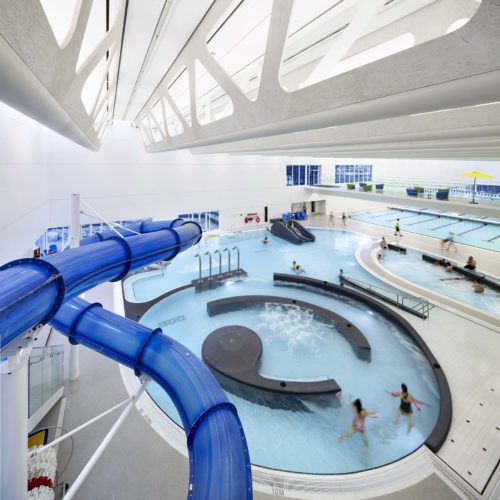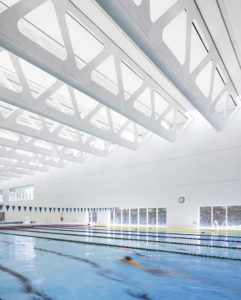New B.C. aquatic centre for an ever-growing community

Photos © Raef Grohne Architectural Photographer. Photos courtesy Rockfon
Located 40 minutes from Vancouver, the City of Surrey’s Guildford Recreation Centre is now 10,405 m2 (112,000 sf)—a growing facility for a growing community.
In the next 30 years, one in five metro Vancouver residents is predicted to live in Surrey. The $38.6-million project, which expands the multi-purpose facility by 6970 m2 (75,000 sf), includes a larger fitness centre and lobby, more office space, a bridge and 300 seats for spectators, plus a new aquatics facility. The addition was completed last year, constructed without interrupting the operations of the existing rec centre or parking.
The design/construction team included Bing Thom Architects (BTA), SHAPE Architecture, general contractor Heatherbrae Builders, specialty contractor StructureCraft Builders, and acousticians at BKL Consultants Ltd. BTA led the natatorium’s overall design as it previously had for Surrey’s iconic Central City complex and City Centre Library. Adding to BTA’s experience, SHAPE provided specialization in designing the facility’s pools.
“At Bing Thom Architects, we try to provide unique elements in all our projects. These elements contribute to enhancing the user’s experience of the space and creating iconic forms in the physical landscape,” said BTA’s project manager, Lisa Potopsingh. “With the Guildford Aquatic Centre, these unique elements are the integrated wood trusses and the use of natural light within the natatorium and the pixelated pre-cast panels of the façade.”
Known for its experience with architecturally exposed timber structures and trusses, StructureCraft was involved at the earliest stages of the design process.
“We spent a lot of time together considering the best way to integrate the structural, mechanical, electrical and acoustical elements, so services were not exposed and it was aesthetically pleasing. We wanted to keep things clean, white and modern in the natatorium. The integrated trusses helped in this way and also created some texture to the space,” Potopsingh explained.
“We considered the space, its function, and its construction,” explained StructureCraft’s Brian Woudstra. “We saw the challenge in front of us first, as a performance specification. Structurally, we needed to engineer it in the most efficient way to take the loads. Acoustically, we needed to manage the noise and echoes. All of the lighting in the pool was to be indirect, so we needed a highly reflective material to direct available light throughout the space. Atmospherically, we would be dealing with humidity and chlorine from the pool. Onsite, we knew we would have no storage space and no time to build in the field.”
Given the challenges before them, StructureCraft carefully considered its options. “We proposed a system of 22 trusses, 100-ft [30-m] long each, that would be stored and completed off-site, then craned into place. Each truss would be prefabricated with everything from the roof membrane to the mechanical ducts, sprinklers, light fixtures, insulation and ceiling panels,” said Woudstra.
Ceiling panel selection was critical in meeting the project’s overall performance specification and the building team’s approval. Several different manufacturers were reviewed before choosing the right materials to meet the project’s budget and acoustic, light reflectance, and atmospheric requirements, with proven precedent on other pool projects.
Pools and gyms are notorious for their noise—if the Surrey natatorium was filled with participants and spectators for a competitive event, the volume and echoes could potentially reach painful levels. To mitigate this, the specified ceiling panels are made from stone wool—an inherently high-performing, sound-absorptive material.
The ceiling’s high sound absorption helps control occupant noise levels and prevents excessive reverberance. This also increases speech intelligibility of the audio systems.
The noise reduction co-efficient (NRC) is a measure of a surface’s ability to reduce noise by absorbing sound. A higher number is better—a ceiling with an NRC of 1.00 absorbs a lot of sound, whereas a ceiling with an NRC of 0.00 absorbs very little. The ceiling panels in question achieve an NRC of 0.90.
Further, their smooth white surface reflects up to 85 per cent of all available light.
“Early in the design process, it was determined that lighting would be used as one of the principle elements of the natatorium,” explained Potopsingh. “Lighting reflected off the acoustic panels and the interior wall finish with carefully selected specific tint and gloss levels created a soothing environment, while achieving ASHRAE/IES 90.1-2007 [Energy Standard for Buildings Except Low-Rise Residential Buildings] and FINA [Fédération Internationale de Natation] illumination requirements.”

Given the humid environment of the pool, water-resistant and mould-resistant products were specified. The stone-wool ceiling panels are water-repellent and dimensionally stable at up to 100 per cent relative humidity (RH), and the material also provides no sustenance to harmful micro-organisms. They are made from abundant basalt rock, contain up to 42 per cent recycled material, and have low chemical emissions in indoor air during usage.
“[The ceiling manufacturer] worked with us,” Woudstra said. “They cut the stone wool panels in custom sizes. This made it easy to install the panels. They also re-wrapped and finished the edges to give it a nice, clean look. The modularity of our trusses is a beautiful part of the solution.”
“The middle section of each truss is about 8 feet [2.4 m] wide with a big, fat metal HVAC duct in place. This leaves 3 feet [1 m] to the right and left. The ceiling panels were directly adhered to the underside of the HVAC ducts. [We] worked together to develop the glue adhesive that could withstand the pool area’s performance requirements. On the right and left wings of the truss, the panels were mechanically fastened to the underside of the plywood decking via a lumber furring system,” he added.
Once completed, the prefabricated trusses were loaded onto a truck—at night to minimize disruption to Surrey’s traffic.
“We could get two trusses loaded and trucked to the site each night. During the day, the entire truss then was erected into place using a crane,” said Woudstra. “We really had to watch our layout to achieve the necessary gaps, reveals, and precise fit. Once they were all in place, the whole thing was roofed and weather-tight.”
Celebrating its first anniversary in 2016, Surrey’s new aquatic centre continues to offer its members and guests a recreational and therapeutic destination. In addition to praise from the community, the project earned industry recognition from the Vancouver Regional Construction Association (VRCA). The project and StructureCraft earned the 2015 VRCA Gold President’s Trade Award for the $1 to $3 million category.
The ceiling was chosen for its numerous natatorium-friendly qualities, including resistance to mould, high reflectivity, acoustic attributes, and resilience in the presence of moisture.


